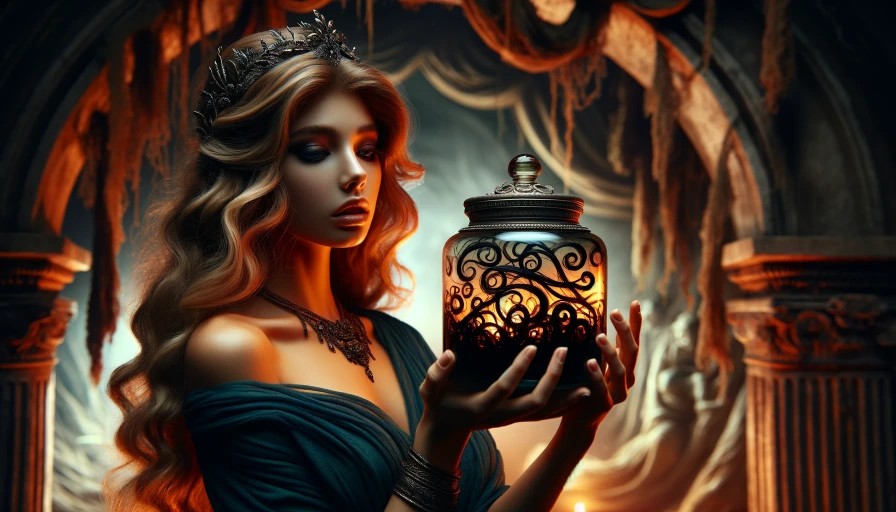Welcome to our exploration of Hebe, the captivating Greek goddess of youth. In Greek mythology, Hebe holds a vital role as the daughter of Zeus and Hera. She serves as the cupbearer to the gods and goddesses of Mount Olympus, bestowing eternal youth, prime of life, and forgiveness upon them.
Hebe’s mythological background is rich and intriguing, making her an integral part of ancient Greek tales. Revered by her fellow gods, Hebe is renowned for her ability to restore youth to mortals, an extraordinary power that adds to her allure and significance. Her Roman counterpart, Juventas, mirrors her divine essence.
Key Takeaways:
- Hebe is the Greek goddess of youth, eternal youth, prime of life, and forgiveness.
- She is the daughter of Zeus and Hera and serves as the cupbearer to the gods and goddesses of Mount Olympus.
- Hebe has the power to restore youth to mortals and is revered by her fellow gods for her role in keeping them eternally young.
- Her mythological background is depicted in various ancient Greek texts, showcasing her importance in Greek mythology.
- Hebe’s symbols include a cup, a flower crown, a golden wreath, wings, eagles, and ivy, all representing her connection to eternal youth and immortality.
Hebe’s Divine Origins and Family Tree
Hebe, the Greek goddess of youth, has a rich and illustrious family tree. She is the daughter of Zeus, the king of the gods, and Hera, the queen of the gods. As the daughter of these powerful deities, Hebe holds a significant position among the Olympians.
Hebe has several siblings, including Ares, the god of war; Hephaestus, the god of fire and craftsmanship; and Eileithyia, the goddess of childbirth. These familial relationships connect Hebe to other prominent figures in Greek mythology, emphasizing her importance in the divine hierarchy.
In addition to her divine lineage, Hebe is also married to Heracles, the renowned hero of Greek mythology. Together, they have two sons, Alexiares and Anicetus, who inherited their father’s strength and heroism.
The mythological background of Hebe is a captivating aspect of her story. It is often depicted in various ancient Greek texts, showcasing her role as the youthful goddess who brings grace, forgiveness, and eternal youth to both gods and mortals alike. Exploring this mythological background further reveals the depth and significance of Hebe’s character.
Through her divine origins and intricate family tree, Hebe’s mythological presence is solidified. It highlights her connection to the gods, her role as a facilitator of eternal youth, and her significance in shaping Greek mythology as a whole.
Symbols and Representation of Hebe
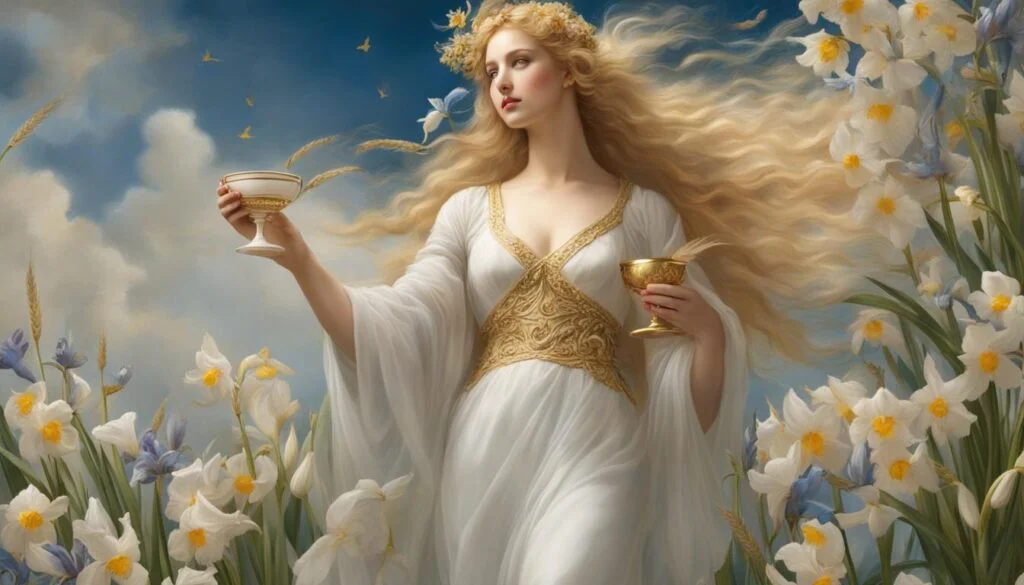
Hebe, the Greek goddess of youth, is often depicted in art with various symbols and representations that highlight her divine qualities and significance. These symbols serve to convey her role and characteristics in Greek mythology.
One of the most common representations of Hebe is as a young virgin, radiating with eternal youth. She is often portrayed holding a cup, symbolizing her role as the cupbearer to the gods and goddesses of Mount Olympus. This cup is believed to contain nectar or ambrosia, the divine drinks that grant immortality and eternal youth to the gods.
In addition to the cup, Hebe is often depicted wearing a flower crown or a golden wreath, emphasizing her association with youth and beauty. These adornments further enhance her divine presence and emphasize her significance as the embodiment of eternal youth.
Some representations of Hebe also include wings, similar to the goddesses Iris and Nike. These wings symbolize her role as a messenger and her connection to heavenly realms, highlighting her divine nature and agility.
Two other symbols associated with Hebe are eagles and ivy. Eagles are often depicted alongside Hebe, as they symbolize strength, power, and immortality, further emphasizing her connection to eternal youth. Ivy, on the other hand, represents fidelity, loyalty, and everlasting life, qualities that align with Hebe’s role as the dispenser of eternal youth.
One recurring representation of Hebe in art is as the cupbearer of the gods, pouring nectar and ambrosia from a pitcher. This portrayal showcases her importance in the divine hierarchy and underscores her responsibility in maintaining the eternal youth and vitality of the gods.
Overall, through these symbols and representations, Hebe’s divine attributes of eternal youth, beauty, and vitality are vividly captured in art, immortalizing her in the rich tapestry of Greek mythology.
The Cult of Hebe
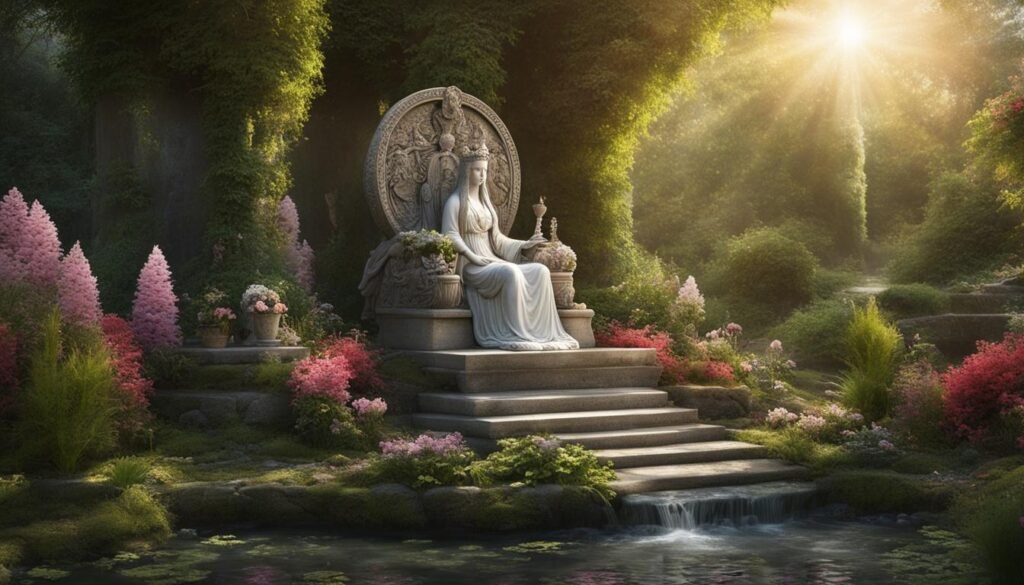
Hebe, the Greek goddess of youth, was revered and worshipped in various ancient Greek cities. One of the prominent cities where Hebe was worshipped was Athens, where an altar dedicated to her stood in the Cynosarges. In other cities such as Sicyon and Phlius, Hebe was known by the name Dia.
The cult of Hebe involved elaborate rituals and offerings. The worshippers would pray to Hebe for forgiveness or mercy, seeking her divine intervention in their lives. People believed that honoring Hebe by releasing prisoners and leaving behind prison chains in sacred groves would appease her and bring about forgiveness.
The ancient Greeks held Hebe in high regard, recognizing her as an important deity associated with youth, rejuvenation, and forgiveness. Through their devotion and rituals, they sought to honor and connect with the divine essence of Hebe.
Image: Hebe, the Greek goddess of youth, was worshipped in ancient Greece.
Hebe’s Role in Greek Mythology
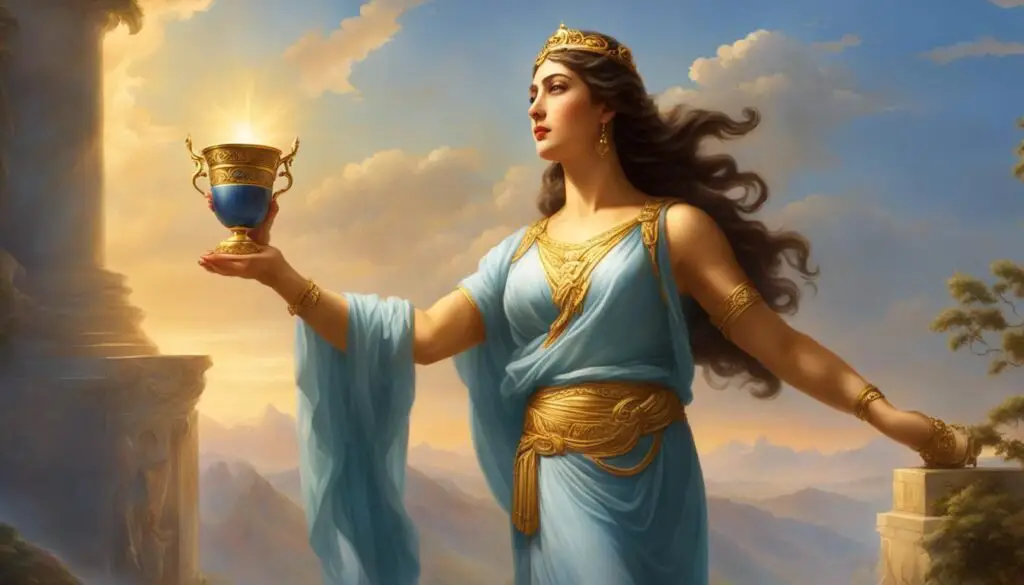
Hebe, the Greek goddess of eternal youth, played a significant role in the mythical tales of ancient Greece. As the cupbearer and attendant of the gods and goddesses of Mount Olympus, Hebe had the important responsibility of serving them wine, nectar, and ambrosia, which ensured their everlasting youth and vitality.
One of the most famous myths involving Hebe is her marriage to the demigod Heracles. This union symbolized Heracles’ ascension to Olympus and his reconciliation with his stepmother, Hera. The marriage between Hebe and Heracles signified the hero’s divine status and exemplified the importance of family and unity among the gods.
Hebe was also renowned for her ability to restore youth to mortals. In various mythological stories, individuals sought her assistance to regain their youth and vitality. This power made Hebe a sought-after figure, representing the desire for eternal youth and the hope for second chances.
Throughout Greek mythology, Hebe’s role as the cupbearer and her ability to restore youth highlighted her importance in the divine realm. Her presence in the myths and legends lent a sense of continuity and beauty to the ancient Greek stories, emphasizing the significance of youth and the eternal cycle of life.
The Divine Charm of Hebe
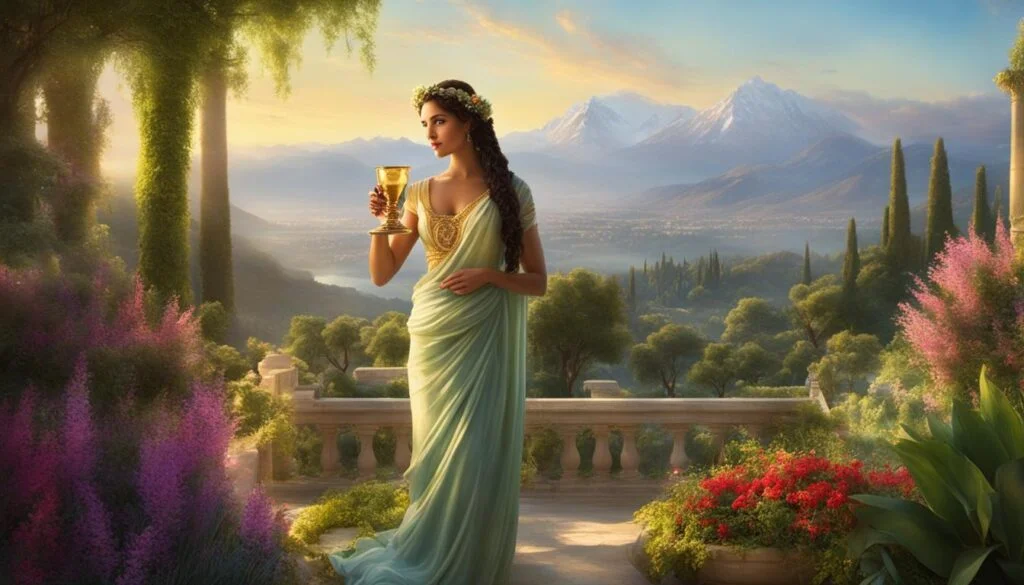
Hebe, the Greek goddess of youth, possesses a captivating allure that is often described as the “fairest of all the goddesses” in ancient Greek texts. Her beauty and charm are highly revered among the Olympians, and she holds a significant role in Greek mythology.
Admired for her youthful grace and elegance, Hebe’s presence as the cupbearer and attendant of the gods further enhances her divine charm and importance. She embodies the epitome of youth and eternal beauty, captivating the hearts of both gods and mortals.
Restoring Youth and Embodying Beauty
One of the key attributes that make Hebe an influential figure in Greek mythology is her ability to restore youth. She holds the power to rejuvenate mortals, symbolizing the everlasting cycle of life and the pursuit of eternal beauty.
Her association with eternal beauty resonates deeply in Greek mythology and adds to her status as a beloved figure. Hebe’s role in preserving the youthfulness of the gods and goddesses emphasizes the divine essence of her charm.
- Her captivating allure and beauty inspire artists and poets alike, immortalizing her in art and literary works.
- The representation of Hebe in art often showcases her as a young virgin, delicately holding a cup and adorned with a flower crown or golden wreath.
- The depiction of wings symbolizes her connection to other winged goddesses, such as Iris and Nike.
- Eagles and ivy, associated with eternal youth and immortality, are often seen alongside her, solidifying her importance in the realm of beauty and youth.
Hebe’s youthful charm, divine presence, and association with eternal beauty make her an integral and captivating figure in the rich tapestry of Greek mythology.
Conclusion
Hebe, the Greek goddess of youth, plays a timeless role in Greek mythology as the cupbearer to the gods and the symbol of eternal youth. Her myths and legends showcase her significant role in Greek mythology, emphasizing her marriage to Heracles and her power to restore youth to mortals. Hebe’s representation in art and the devotion of her cult further reinforce her importance in ancient Greece.
As the embodiment of divine charm and beauty, Hebe holds a beloved and revered status among the Olympians. Her role as the cupbearer and attendant to the gods adds to her allure and significance. With her ability to restore youth and her association with eternal beauty, Hebe remains an enduring figure in Greek mythology, representing the perpetual cycle of youth and the splendor of life.
Through her myths, legends, art, and worship, Hebe leaves a lasting impression on Greek culture. Her stories continue to be told and celebrated, capturing the imagination and admiration of those who appreciate the enduring power of youth. Hebe’s role in Greek mythology and her timeless appeal attest to the enduring relevance and fascination with the eternal beauty of youth.
FAQ
Who is Hebe in Greek mythology?
Hebe is the goddess of eternal youth, prime of life, and forgiveness in Greek mythology. She is the daughter of Zeus and Hera.
What is Hebe’s mythological background?
Hebe is the daughter of Zeus and Hera. She is married to Heracles and they have two sons, Alexiares and Anicetus.
What are the symbols associated with Hebe?
Hebe is often depicted holding a cup and wearing a flower crown or a golden wreath. She is sometimes shown with wings, and eagles and ivy are also associated with her.
Was Hebe worshipped in ancient Greece?
Yes, Hebe was worshipped in various ancient Greek cities, including Athens, Sicyon, and Phlius. She had an altar in the Cynosarges and was known as Dia in Sicyon and Phlius.
What was Hebe’s role in Greek mythology?
Hebe served as the cupbearer and attendant of the gods on Mount Olympus. She was responsible for serving them wine, nectar, and ambrosia, ensuring their eternal youth.
Why is Hebe considered the "fairest of all the goddesses"?
Hebe is described as the “fairest of all the goddesses” in ancient Greek texts because of her beauty, charm, and youth. Her role as the cupbearer and attendant of the gods adds to her allure and significance among the Olympians.
What is the cult of Hebe?
The cult of Hebe involved rituals and offerings. She was often prayed to for forgiveness or mercy, and people believed that releasing prisoners and leaving behind prison chains in sacred groves honored Hebe and sought her forgiveness.



